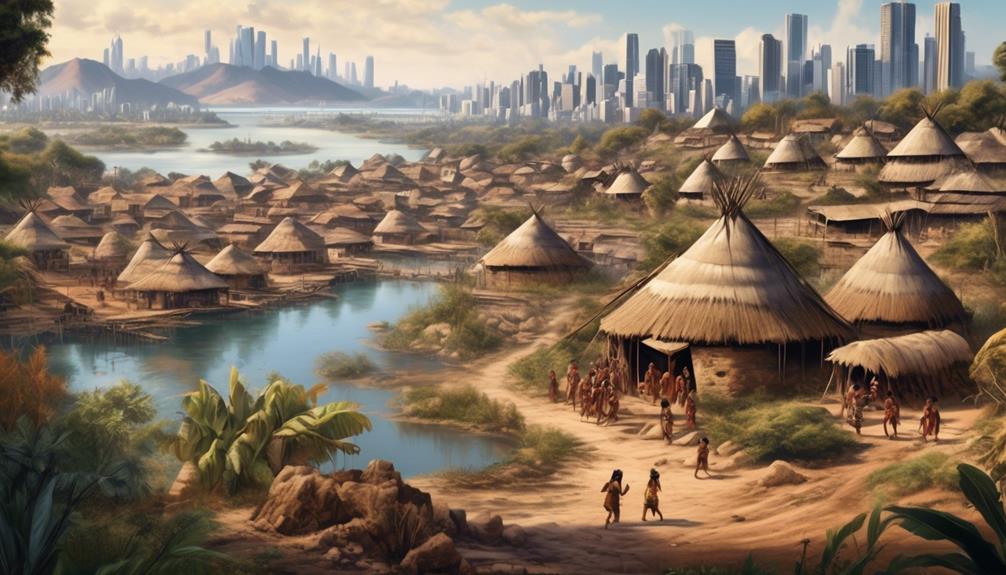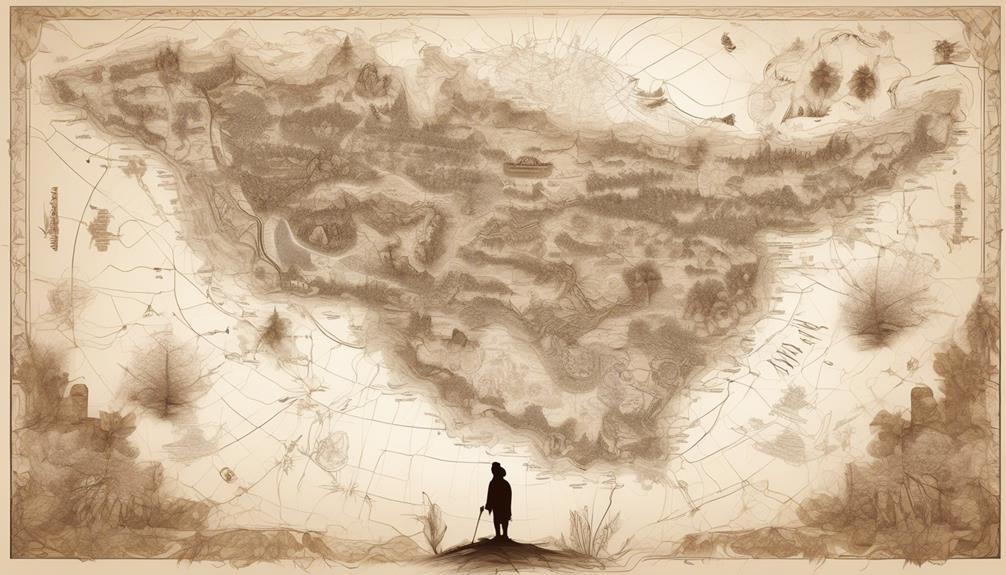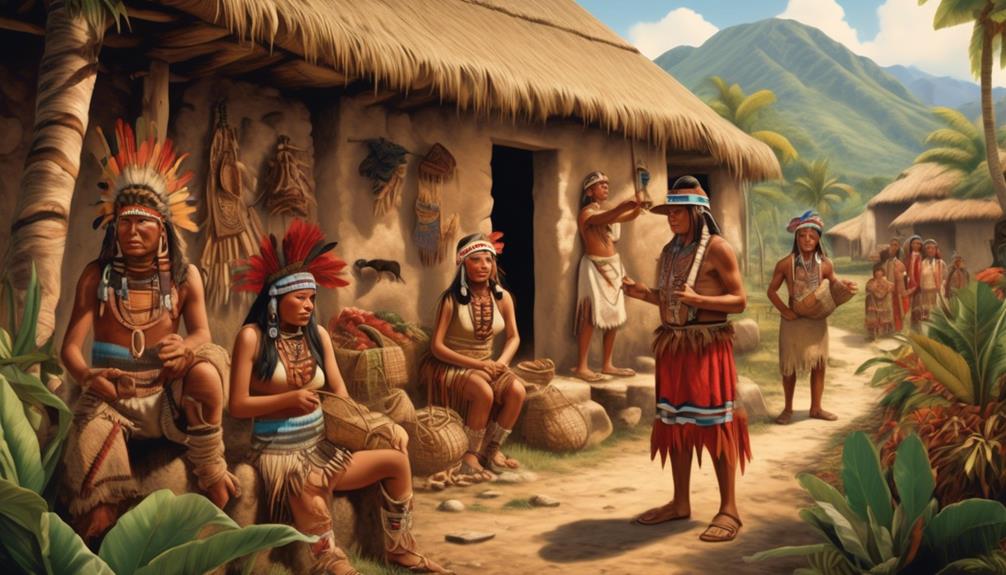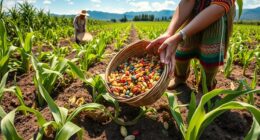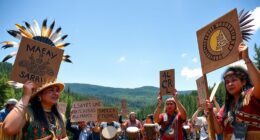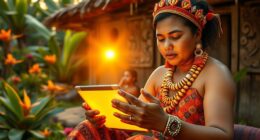During the era of colonization, indigenous groups in the region experienced permanent changes. The effects of colonization on these communities were significant, affecting all areas of their lives. From displacement from their ancestral lands to the introduction of new diseases, the repercussions of this historical period continue to be felt today.
But how did these changes truly shape the trajectory of indigenous groups in this region? What enduring legacies did colonization leave behind, and how do they continue to shape the lives of these communities today?
Key Takeaways
- Loss of traditional lands and environmental impact severing vital connections to cultural heritage and way of life
- Introduction of new diseases and devastating impact on healthcare within indigenous communities
- Forced assimilation and cultural erasure through the deliberate campaign to erase cultural identity
- Economic exploitation and labor exploitation leading to poverty, inequality, and loss of cultural identity
- Legal and political marginalization resulting in underrepresentation, limited access to justice, and disenfranchisement
Loss of Traditional Lands
Losing traditional lands has been a devastating consequence of colonization for indigenous groups, severing vital connections to their cultural heritage and way of life. The cultural displacement resulting from the loss of their ancestral territories is profound, as these lands hold the stories, traditions, and spiritual significance that are integral to their identity.
Moreover, the environmental degradation that often follows colonization further compounds this loss, as the land isn't only a physical space but also a source of sustenance and a reflection of indigenous cosmologies.
The forced removal from their traditional lands disrupts not only the physical connection to the environment but also the intricate relationship that indigenous communities have with the natural world. This rupture has far-reaching implications, impacting their ability to practice traditional land management techniques and threatening the survival of endemic flora and fauna.
As a result, the loss of traditional lands due to colonization represents a multifaceted assault on the indigenous way of life, with enduring repercussions for cultural, spiritual, and environmental well-being.
Introduction of New Diseases
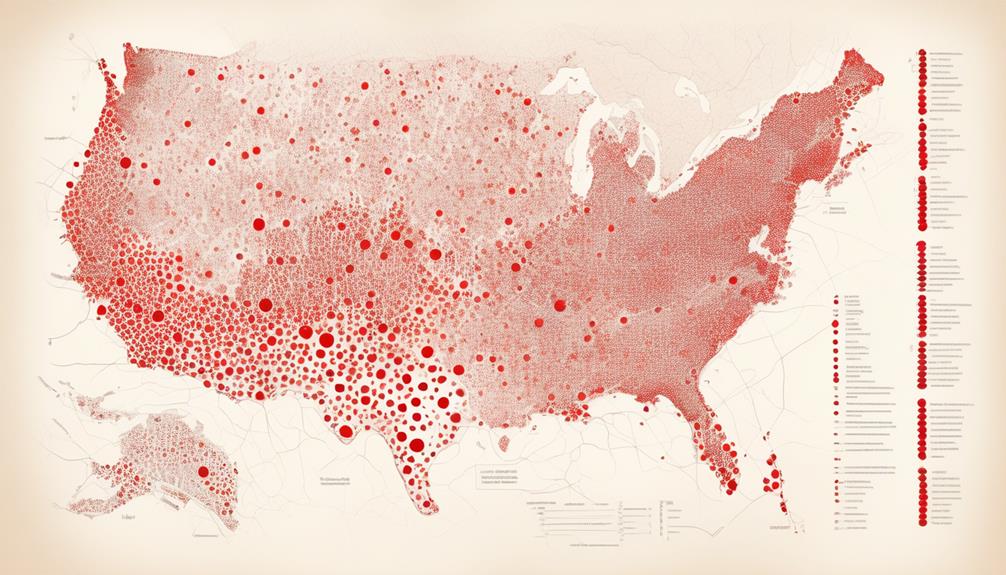
The disruption caused by the loss of traditional lands due to colonization reverberates deeply, and one of the consequential impacts was the introduction of new diseases to indigenous communities, fundamentally altering their health and well-being. The arrival of colonizers brought diseases such as smallpox, measles, and influenza, to which indigenous groups had little to no immunity. This had a devastating impact on healthcare within these communities, leading to high mortality rates and significant challenges in maintaining overall well-being.
Despite the immense toll, indigenous groups exhibited remarkable resistance and resilience in the face of these new diseases. They leveraged their traditional knowledge and healing practices to develop innovative strategies for combating and managing the impact of these illnesses. Additionally, community support and solidarity played a crucial role in providing care for the sick and rebuilding healthcare systems.
The introduction of new diseases became a catalyst for the preservation and adaptation of indigenous healthcare practices, demonstrating the strength and perseverance of these communities in the wake of immense adversity.
Forced Assimilation and Cultural Erasure
During the era of colonization, indigenous communities experienced a deliberate and systematic campaign aimed at erasing their cultural identity through forced assimilation tactics and policies. Forced assimilation, often enforced through boarding schools and repressive laws, sought to strip indigenous peoples of their language, traditions, and beliefs, imposing the culture of the colonizers upon them. This resulted in a profound cultural erasure, as practices, ceremonies, and knowledge passed down through generations were suppressed or forbidden.
The impact of forced assimilation and cultural erasure continues to reverberate through indigenous communities today. Many struggle to reconnect with their lost heritage and revitalize their cultural practices, facing the challenge of rebuilding what was systematically dismantled. The trauma of this cultural suppression has had deep and lasting effects on indigenous identity, self-esteem, and community cohesion.
Understanding the enduring effects of forced assimilation and cultural erasure is crucial in comprehending the complexities of indigenous experiences. It's a testament to the resilience of indigenous peoples that despite centuries of systematic efforts to eradicate their cultures, many are now actively engaged in cultural revitalization and preservation, seeking to reclaim and celebrate their unique identities.
Economic Exploitation and Labor
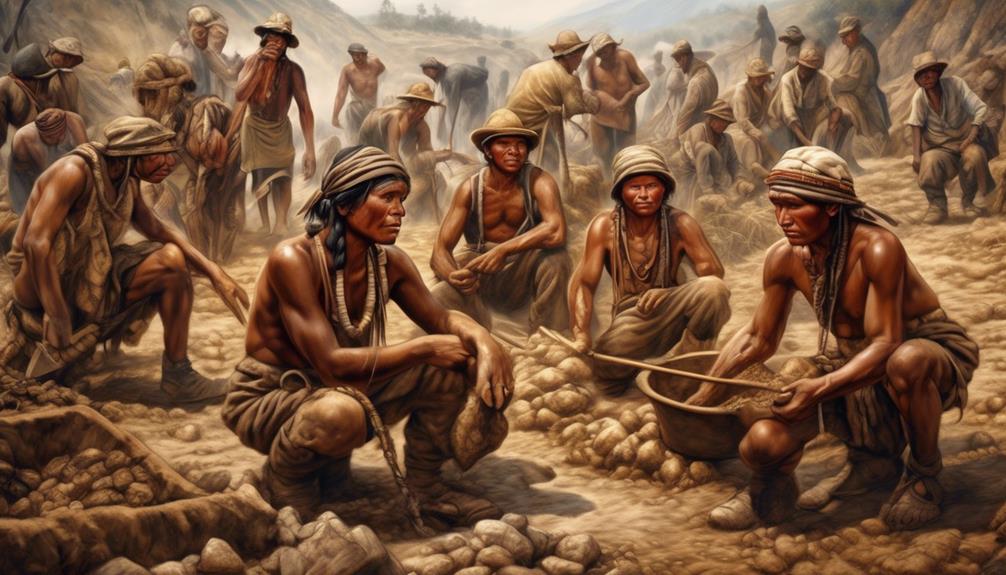
The lasting impact of forced assimilation and cultural erasure is intricately intertwined with the history of economic exploitation and labor among indigenous communities. The exploitation of indigenous peoples' labor and resources has left a deep and enduring wound within our communities. From unfair wages to resource extraction, the economic exploitation of indigenous labor has been a systemic issue that has persisted for generations. The forced displacement of indigenous peoples from their ancestral lands has led to land dispossession, further exacerbating the economic vulnerability of these communities. Additionally, the historical practice of indentured servitude subjected indigenous individuals to exploitative labor conditions, perpetuating cycles of poverty and inequality.
| Types of Economic Exploitation | Impact on Indigenous Communities |
|---|---|
| Unfair wages | Economic vulnerability and poverty |
| Resource extraction | Environmental degradation and loss of traditional livelihoods |
| Indentured servitude | Generational impact on labor conditions and socioeconomic status |
| Land dispossession | Loss of cultural identity and connection to ancestral lands |
The legacy of economic exploitation and labor continues to shape the socioeconomic landscape of indigenous communities, highlighting the urgent need for reparative justice and equitable economic opportunities.
Legal and Political Marginalization
Experiencing the enduring repercussions of historical injustices, indigenous communities have faced systemic legal and political marginalization, perpetuating a cycle of disenfranchisement and powerlessness. The impact of this marginalization has been profound and pervasive, shaping the social, economic, and cultural landscapes of indigenous groups in our region.
- Underrepresentation in Political Institutions: Indigenous communities have historically been marginalized in political processes, resulting in limited representation and influence in decision-making. This has led to policies and laws that don't adequately address their needs and concerns, further exacerbating their marginalization.
- Legal Disenfranchisement: The legal system has often failed to protect the rights and interests of indigenous peoples, leading to a lack of access to justice and recourse for injustices. This has perpetuated a sense of powerlessness and alienation within indigenous communities.
- Cultural and Linguistic Marginalization: Indigenous languages, traditions, and governance systems have been marginalized within the political and legal frameworks, undermining the cultural identity and autonomy of indigenous groups.
The marginalization impact on political representation continues to be a significant challenge for indigenous communities, necessitating comprehensive efforts to address historical injustices and create inclusive and equitable political systems.
Frequently Asked Questions
How Did Colonization Affect the Spiritual and Religious Practices of Indigenous Groups in This Region?
Colonization profoundly impacted the spiritual practices of indigenous groups in this region. Cultural assimilation forced many to abandon their traditional beliefs and adopt the religion of the colonizers. This resulted in a loss of cultural identity and a disruption of sacred rituals.
The forced conversion often led to a suppression of indigenous spiritual practices, causing deep pain and alienation within these communities. The impact on spiritual and religious practices was a profound and lasting consequence of colonization.
What Impact Did Colonization Have on the Availability of Natural Resources for Indigenous Communities?
The impact of colonization on the availability of natural resources for indigenous communities was profound. Land was often forcibly taken, disrupting traditional ways of life and causing scarcity of vital resources. This led to cultural assimilation as indigenous groups had to adapt to new, often unsustainable, resource practices imposed by colonizers.
The loss of control over their land and resources had lasting effects on indigenous communities, affecting their cultural, spiritual, and economic well-being.
How Did Colonization Disrupt Traditional Social Structures and Governance Systems Within Indigenous Groups?
Colonization disrupted traditional social structures and governance systems within indigenous groups. The impact was profound, affecting our cultural cohesion and leadership dynamics.
Our communities faced a significant upheaval as the colonizers imposed their systems, undermining our established ways of organizing and governing. This caused widespread disorientation and loss of autonomy, fundamentally altering our social fabric.
Understanding this disruption is crucial for comprehending the lasting effects of colonization on indigenous groups.
What Long-Term Effects Did Colonization Have on the Mental Health and Well-Being of Indigenous Communities?
Colonization deeply impacted the mental health and well-being of indigenous communities.
Studies show that rates of depression, anxiety, and suicide are significantly higher among indigenous populations compared to non-indigenous groups.
The loss of traditional lands, cultural practices, and forced assimilation have contributed to this ongoing struggle.
These long-term effects highlight the importance of recognizing and addressing the historical trauma and providing culturally sensitive support for indigenous communities' mental health and well-being.
How Did Colonization Impact the Preservation of Indigenous Languages and Knowledge Systems?
Preservation of indigenous languages and knowledge systems was severely impacted by colonization. Education policies suppressed traditional languages, hindering language revitalization and transmission of traditional knowledge. This caused a loss of cultural identity and intergenerational disconnect.
Efforts to preserve and revitalize indigenous languages and knowledge systems are crucial for cultural resurgence and community well-being. It's a complex and ongoing process that requires collaboration and support from wider society.
Conclusion
In the wake of colonization, the indigenous communities in this region have experienced a stark transformation. Their traditional lands have been lost, their cultures eroded, and their voices marginalized. The impact of colonization can be likened to a storm that has torn through their way of life, leaving behind a landscape forever altered.
But amidst the destruction, the resilience and strength of these communities continue to shine like seeds pushing through the cracks in concrete, refusing to be silenced.
Mary is a passionate writer who brings creativity and a fresh perspective to our team. Her words have the power to captivate and inspire, making her an essential contributor to our content. Mary’s commitment to storytelling and dedication to promoting Indigenous culture ensures that her work touches the hearts of our readers. We’re fortunate to have her as part of our team.
